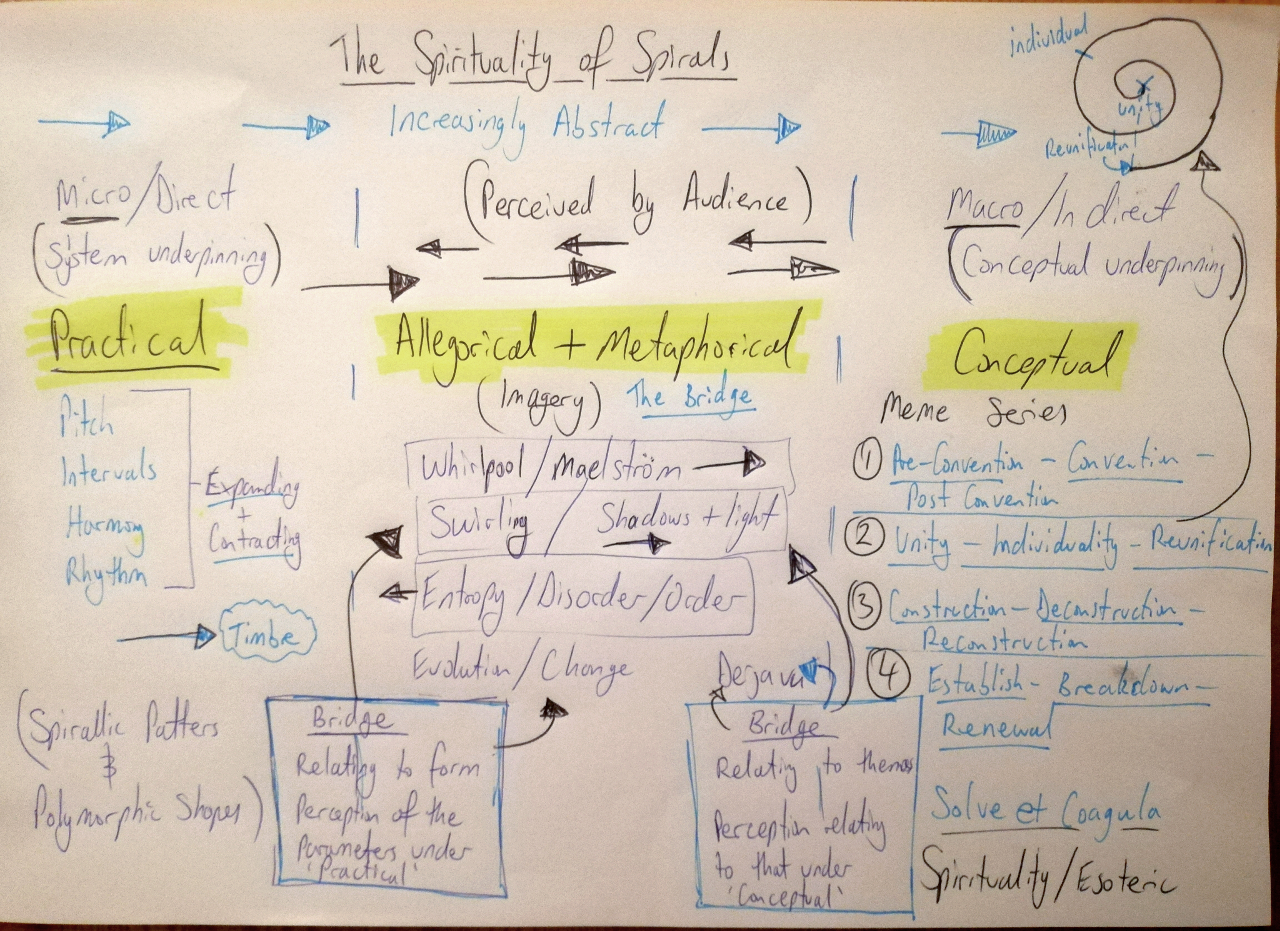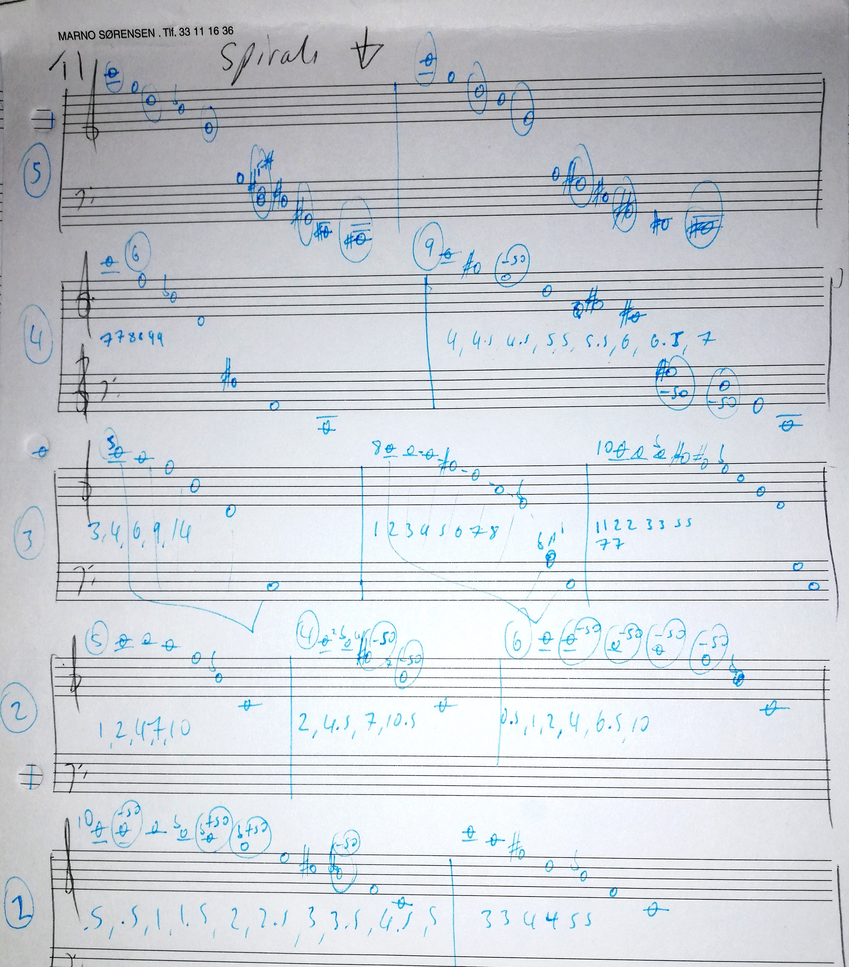The chords are based on these intervals. Of course, many intervals can be viewed when looking at a chord, but with instrumentation, you can split up the pitch sets so they are more pronounced (for example giving the two trumpets two intervals to outline the chord). The score to the right outlines the raw pitch sets for the background chords underneath the bassoon/percussion duo soli.
During this time, I was inspired by the notation and aesthetic style of Lotte Anker’s work, What River Is This? (2014) as well as the non-linear scores influenced by Ligeti, Stockhausen and Cage. During the composition process, I recorded with Jacob Anderskov on his album for clarinets/flutes/basses/drums called Spirit of the Hive (2021). There was a similarity to how the music unfolded between that and Murmuration. It was beneficial to glean further insight into how I can approach my rehearsals when it comes to this music.
Within Part II: Into the Maelström the two teams play melodies based upon different pitch sets. Originally I had Team 1 moving in pitch sets that started with 1 octave and grew to 5 octaves, and then the reverse for Team 2. However during the compositional process, I decided to have the two teams join up around two thirds through. This Team 1 VS Team 2 concept encouraged the musicians to focus their listening to one another. I found it a useful technique to engage the musician’s interplay and blending within a group improvisation.
I have the following considerations regarding how an intervallic system could be absorbed by fellow musicians to be utilised for improvisation:
Open segments within a strict confine: “play this rhythmic material but only use these five pitches”
Simplification of systems- eg. if a system is based on a decatonic scale then it is easier to instruct “every note except these two notes”
Cues: written, hand, conducting
Through extensive practice (this is hard to do with a large ensemble) à la Coltrane changes.
Out of the above points, 1 and 3 became useful in managing these works. I compose music where I am ‘written in’/performing too, which means there is a level of detail that is only communicated in rehearsals — not on the score.
Another pivotal development occurred during the composition process of Murmuration— I was introduced to the pipe organ. As I finalised the composition in the second semester, I was spending even more time with my saxophone and the organ.
In the second piece of this research project; Renewal Manifestation (written for Organ, Saxophone, String trio, involving improvisation and unorthodox score notation), I utilised the expanding pitch sets technique for the beginning and end of the work. For Part I and Part IV I utilised the expanding sets (chords built off 6ths, 7ths then 9th).
In Murmuration Part III: Headland, the pitch sets serve as the basis for these shifting chords, they are over 5 octaves and then meet on an F and G dyad. In this piece, you can hear the influence of the organ creeping in. The piece ends with the same chords as the start of Part I, just down a 5th. There is a warping technique that I have been developing, where the ensemble plays very slow wide vibrato to emulate an old tape machine.
Starting with the left-hand side of the graph in Figure 1 (above), Direct Practical Implementations relate to expanding pitch, intervalic, rhythmic and harmonic sets. I commenced this research project by investigating practical utilisations of spiral formations through my large ensemble Murmuration. Murmuration fuses together a mixture of ambient, free jazz and contemporary classical styles. I began by developing a series of spiral intervalic sets.
The sets had two main rules:
1. The beginning pitch could not repeat (all starting with C, with transposition being left until the compositional process)
2. Rows that expand or contract, the rate could not stay constant.
These intervalic sets were placed in four groups; Ascending Expanding, Ascending Contracting, Descending Expanding and Descending Contracting. They ranged from one to five octaves. The section in PSSP (Appendix) on uneven scales elaborates further on this.
The concept was that Murmuration would incorporate two opposing spirals, developing at different rates. Throughout the score, I used the terms Team 1 (T1) and Team 2 (T2) (notation on the right). These teams appear throughout the piece and through these intervalic sets, I would derive melodies by presenting the pitches and then adding rhythm, timbre, and dynamics. In a similar manner, I would create harmony by stacking the intervals.
I spent three months developing and composing with these pitch sets. Sometimes writing in tones to improvise with, and at other times breaking them down into interval symbols for improvisation1.
This was all going well, until the first rehearsal four months in. The musicians did not take to the composition, nor improvisational ideas. It is one thing to compose using systems, but another to incorporate them into the basis of improvisation. Rather than sounding like a vibrant merging of orchestrated material and spirited improvisation, the music inhabited an in-between space. Purgatory. The compositions were too open and the improvisations were too stiff. I began to call into question some fundamentals of music.
“…what is a composition? What is an improvisation? Is anything truly improvised? Doesn’t improvisation correspond more to the state of mind than the actual techniques/melodies/rhythms/textures displayed?...
...what even is an extended technique? Isn't it all about context? Jazz saxophonists playing with perfect intonation is pretty extended…”
Reflection Journal 23.01.2021
On the back cover of Slonimsky’s ‘Thesaurus of Scales and Melodic Patterns’ lie several endorsements by world-renowned composers; Bernstein, Cowell, Virgil Thompson et. al. All heap praises upon Slonimsky’s extensive work; however, one composer does not — Arnold Schoenberg. His endorsement reads slightly differently:
“I looked through your whole book and was very interested to find that you have, in all probability, organised every possible succession of tones. This is an admirable feat of mental gymnastics. But as a composer, I must believe in inspiration rather than in mechanics”
I initially scoffed at this quote (Schoenberg…? Really?). However, after some contemplation, I began to consider what Schoenberg potentially meant. Perhaps we could paraphrase him with a more modern vernacular:
“So you have a system? Good for you! What is it worth if you cannot create from it?”
In another way, you could say to a house “these are some nice bricks” or “what lovely mortar you have!”. I assume that Schoenberg meant no disrespect. I would hazard a guess that he perceived Slonimsky’s book precisely for what it is — an extensive repository of scales and patterns. Perhaps Schonberg’s comment was a thought he also had towards his own systems. His own twelve-tone rows.
Having realised in the first rehearsal that the musicians were not taking to the written material as I envisioned, I adapted by deciding that this research project would not predominantly concern itself with showcasing a system. If the system was the protagonist of a story, then I would represent the counter-narrative or the subplot that is happening concurrently with the main events. It would be about the system’s effects. I began to ask myself, what do spirals represent?2 What are the metaphorical and allegorical implications of a spiral?What metaphysical elements are drawn from this image?
The project began to center around my experience of utilising this system as an improviser (internal communication) and as a composer (external communication). Through this, I developed a subsequent question for the ‘Murmuration’ project: “How can I merge systematic and emotive systems in a large ensemble?”
Taking on a more unrestricted interpretation of the tonal material led to the spiral tonalities still being portrayed but with slight deviations.3
Later on in Part I of Murmuration, I utilised a different section of PSSP, the reordering pitch set concept where the intervals are reordered:
Semitone - Whole tone - Minor 3rd - Major Third - Tritone- Minor 6th - Major 6th - Perfect 4th - Minor 7th - Perfect 5th - Major 7th- Minor 9th.
The initial foundation of this research project was the development of my intervalic and tonal system, entitled Polymorphic Shapes and Spiralic Patterns (PSSP). An outline of the system is attached in the Appendix. I encourage you to spend a few minutes skimming it over.
A spiral is a cycle that changes upon revolution. In short, PSSP utilises cyclic intervalic sets that expand and contract at varying rates upon each revolution of the cycle. The aim was that by employing this material as a fundamental for improvisation and composition the music would exhibit a moving sensation, finding a place between open composition and structured improvisation.
3 Akin to jazz improvisation- where over an F minor chord one might substitute any alterations (playing off Bb7, Bb alt, Bb diminish dominant, B-6 pentatonic, Ab- or B-, E7, (and the list goes on). But no matter the deviation, if the musician returns to playing the Ab and Eb the home tonality will begin to appear again.
Around this time I was in contact with Norwegian organist Nils Henrik Asheim’s asking him about different extended techniques for pipe organ. His album Vox Humana (2018) is a duo between organ and voice. I took inspiration for the bassoon solo on Murmuration from the Norwegian vocalist Ruth Wilhelmine Meyer (Vox Humana) where she employs her extreme range and extended vocal techniques, such as tone splitting and throat singing. In the composition, I aimed to emulate her timbral quality in the multiphonics, microtones and the almost three and a half octave range of the bassoon in the first section (the audio example towards the top of this section with bassoon and drums).
There is a certain spectral quality to Murmuration. It is clear when I hear the first few minutes that the sound of the organ inevitably seeped into the opening section. The beginning section of Murmuration is directly influenced by the technique of half pulling stops. By using weights on the keys of different manuals within the organ and then subtly pulling the different voices you can make the chords slowly shift with additional secondary sounds popping out (air, harmonics, cracks, whistles etc). With this comes the subtle and uneven vibrato of different pitches, leading to a homogenous morphing entity.
The following is in reference to the rhythmic implications that pertain to the left-hand box ‘practical parameters under the structural form’. In Parts 1 and 2 of Renewal Manifestation are broken down and pieced together (Appendix B) from a British tongue twister “how much wood would a wood-chuck chuck if a woodchuck could chuck wood?” (in 13/8 or 7/4 depending on your rest at the end).
In a general sense, my final project Although Changed, I Arise the Same (a piece for reconstructed organ, saxophone and two voices. It is the project which will be featured in the Solist concert) did not function with PSSP at its core. Not to say it did not have an influence. There are many pitch sets similar to Murmuration and Renewal Manifestation - wide arpeggios made of pairing Semitones, Perfect 5th and Minor/Major 6ths, allowing for the perception of expanding and contact chords. The full tone list for this project with my Reconstructed Organ is below for reference.

